Electrification in industrials
Transitioning to a lower-carbon future through electrification of industrial processes, spaces, and fleets
Introduction
Most industrial manufacturers are just beginning to realize the economic viability of electrification in industrial fleets, processes, and spaces. Electrification in these areas seems to be gathering momentum for several reasons. First, the US electric utility sector is largely decarbonizing as lower-cost natural gas becomes more economical than coal-fired power, and as the cost of renewables continues to decrease.1 Second, as energy storage costs continue to decline, electrification of vehicles is beginning to make more economic sense due to lower maintenance and fuel costs. Third, customers appear to be growing more concerned about environmental and sustainability issues, and want their suppliers to become greener.
Learn more
Explore the Energy transition series
Browse the Industrial Products collection
Learn about Deloitte’s services
Go straight to smart. Get the Deloitte Insights app
The growing trend toward electrification appears to reflect the broader energy transition (see sidebar, “Understanding the energy transition”). Industrial fleets, processes, and spaces are three key areas of energy transition in manufacturing, and electrification of these domains is a first step toward increasing system efficiency and decarbonization. A recent Deloitte executive study revealed that more than 70% of respondents have agreed to move toward electrification of industrial processes and more than 50% of respondents have targeted electrification of space and water heating and fleets within their ecosystem by 2030.2
Understanding the energy transition
Electrification is a key part of decarbonizing energy sources, one of the six channels of the energy transition identified in Navigating the energy transition from disruption to growth.3 Energy transition is the process of reducing reliance on fossil fuel across the economy and moving toward greater use of cleaner energy sources such as renewables. The six channels along which progress in the transition is measured include: decarbonizing energy sources, increasing operational energy efficiency, commercialization of new technologies, investment in new business areas, adjusting to new policy mandates, and managing customer and stakeholder expectations.
This article identifies the macro trends that are driving adoption of electrification in industrial products and the impact it is having on industrial fleets, processes, and spaces. It provides a timeframe for their penetration and offers key considerations for planning and timing investments in electrification.
Why now? Electrification and the rise of sustainability as a corporate mandate
Over the past several years, there has been a shift underway toward electrifying certain aspects of industrial operations. Simultaneously, many companies have published sustainability reports, detailing their strategies for increasing energy efficiency, reducing landfill waste, and lowering greenhouse gas (GHG) emissions. More recently, on the heels of the 2020 Davos economic conference, global manufacturing leaders expressed support for establishing a common set of environmental, social, and governance (ESG) metrics and disclosures in recognition of the sustainable development goals (SDG) as important to long-term business value creation.4 In the 2020 Deloitte Energy Transitions survey, the majority of manufacturing executives indicated that improving environmental stewardship and increasing sustainability efforts were critical to becoming a leading organization in the future. In addition, 55% of manufacturing leaders confirmed that sustainability efforts have high-level support from their board of directors, which sets the strategy and goals, and then shares these goals with the executive management team for execution.5
The changes taking place in the power sector are also providing impetus to industrial manufacturers and assisting in electrification efforts in two ways. First, the decarbonization of the US power sector is well underway, with renewables’ installed capacity exceeding that of coal as of Q1 2020.6 As the cost of renewables alone and with storage continue to decline, renewables will continue to account for larger market share, allowing utility customers to benefit from lower-carbon electricity and reduce their carbon footprint. Second, a priority for utilities is helping their customers electrify. Seventy-percent of utility executives surveyed responded that the three critical areas for helping customers electrify include vehicles, industrial processes, and buildings (heating and cooling.)
Increasing nudges from investors, leaders, and customers are encouraging manufacturers to set ambitious targets. Industrial manufacturers surveyed across sectors target achieving 45% overall electrification by 2035, higher than their current rate of 35%.7 When asked how these goals could be met, 64% of manufacturing leaders cited plans to leverage partnerships and joint ventures to transition toward a sustainable future, while 61% will rely on outsourcing strategies with vendors and suppliers.
While the push toward electrification is in part a response to the increased focus on sustainability, industrial manufacturing is also driven by an underlying need to increase efficiencies and manage operational costs. These are often significant drivers in any decision to change energy sources. In fact, “reducing energy and overhead costs” and “improving the environment” are the top two benefits manufacturing executives surveyed are expecting from their long-term sustainability strategies.8 It is likely that these two drivers will continue to be intricately interwoven throughout the transition toward cleaner energy in manufacturing.
Where electrification is occurring in industrial manufacturing: Fleets, processes, and spaces
Electrification adoption varies from one industry to another, but each industry has made dedicated efforts in this direction. Electrical equipment and machinery manufacturers source almost 40% of their energy requirements from electricity.9 The machinery and equipment manufacturing sectors are poised to stay ahead of the curve in electrification adoption (figure 1). The future of electrified systems within industrial manufacturers looks promising, with increasing penetration rates among a majority of companies analyzed for this study.
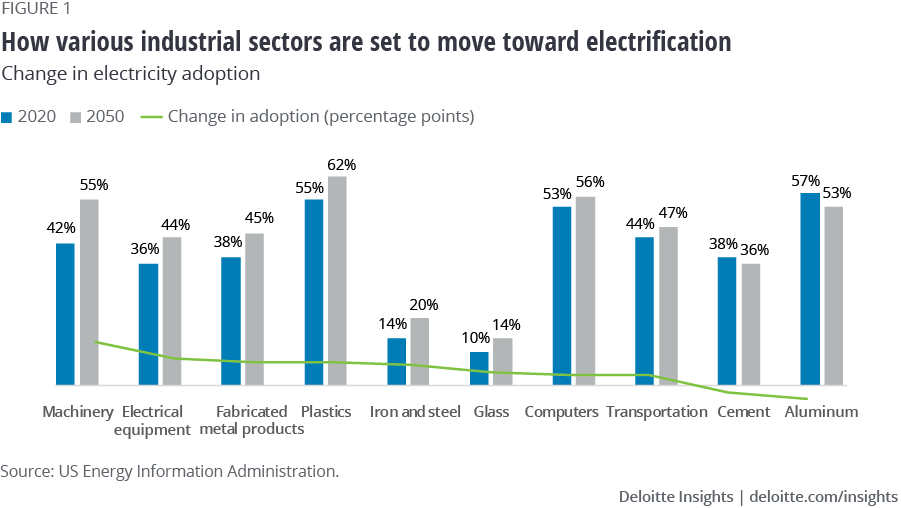
Industrial fleets: Electrification is much closer than earlier estimated
Industrial companies are experimenting with electrifying equipment and industrial fleets. Some companies are slowly transitioning to electric equipment ranging from tugs to forklifts. These electrified equipment classes can be cheaper to maintain and to operate on average than their diesel equivalents. They also tend to be quicker and easier to maneuver and thus can be preferable for indoor applications. In addition, companies are weighing the benefits of transitioning to an electric vehicle fleet (figure 6). This transition entails upfront investment in vehicles and charging infrastructure, and the return on this investment would be realized through savings on fuel costs and maintenance over the life of each vehicle.10 Electric vehicles have far fewer moving parts and use fewer fluids than internal combustion engine vehicles, meaning the maintenance costs of an electric truck are substantially lower than those for gasoline and diesel powered vehicles over the life of the vehicle. In addition, power costs can be slightly lower and less volatile than gasoline or diesel costs, though these factors tend to vary by region.11
Meanwhile, an ecosystem is developing to support fleet electrification, with companies focused on offering the services that a manufacturer may not be able to provide itself. Examples include offering fleet charging management systems to optimize charging across the fleet and taking advantage of time-of-day charging to benefit from lower electricity costs. Similarly, once battery capacity has declined and replacement is required, there are service providers that offer not only battery replacement but will also manage the redeployment of the old vehicle battery into second-life applications in the power sector and elsewhere.
For these reasons, manufacturing leaders plan to adopt electric vehicles (EVs) over the next decade for transportation and logistics as a means of shifting toward low-carbon fuel alternatives. They view this as a way to also increase fleet management efficiencies. A recent Deloitte survey identified that a majority of industrial manufacturers have targets of almost 40% fleet electrification by 2035 (figure 2).12
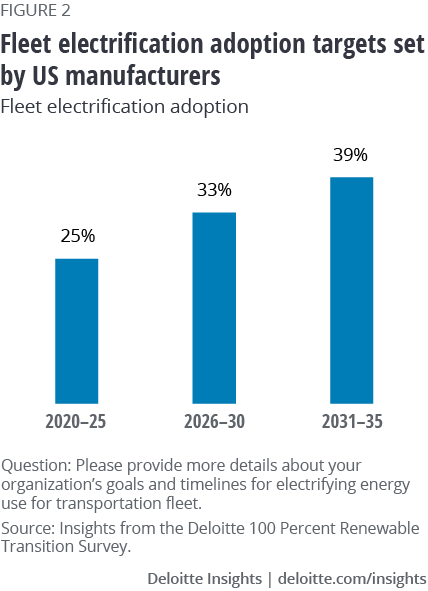
Policies incentivizing vehicle electrification remain in place in some areas, including country-level emission regulations (for example, potential carbon dioxide fleet targets) and local access policies (for example, emission-free zones). In the United States, Phase 2 emission standards, passed in August 2017, target trailers and heavy-duty pickup trucks to reduce fuel consumption by 9% and 17%, respectively, by 2027.13 These efforts will likely spur industrial companies to create a pathway toward electric fleet adoption that adheres to these policies.
Even as industrial manufacturers seek to transition their fleets toward electric power, certain challenges need to be addressed. A recent Deloitte study identified lack of management buy-in and funding as two main hurdles.14 Also, as the transition occurs, likely over a number of years, there is expected to be an overlap of infrastructure and supply chains for spare parts and services related to both internal combustion engines and EVs. This could impact short-term costs and serve as a deterrent. Other barriers include reliability, battery lifetime and costs, and product knowledge among fleet owners and drivers.
Industrial processes: From production lines out through the supply chain
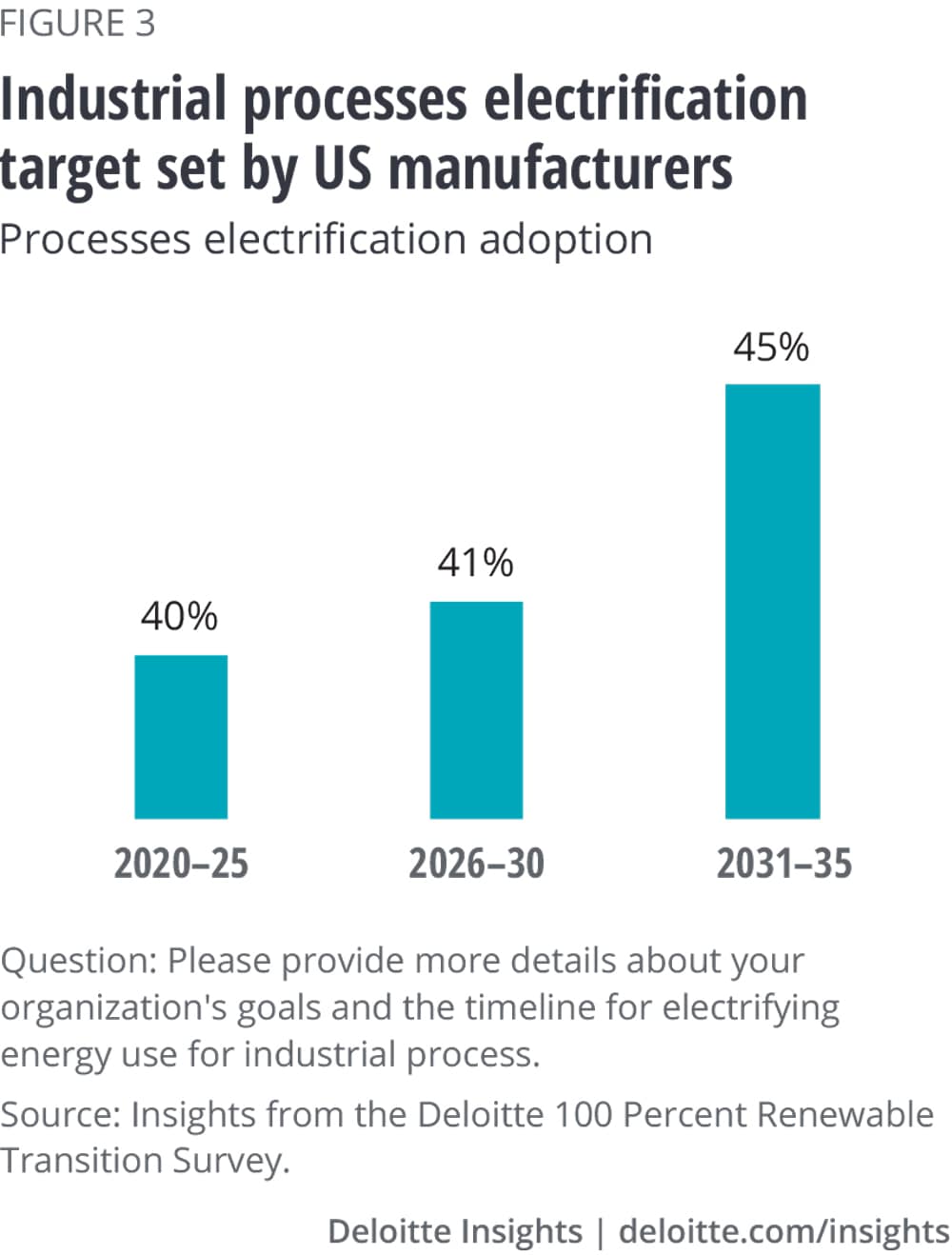
Industrial processes are the backbone of any manufacturing operation and are a focal point for driving efficiencies. Energy supply to processes in industrial manufacturing currently relies heavily on the combustion of fossil fuels, which are either used directly to supply heat or indirectly through utility systems. A recent Deloitte study found that the surveyed manufacturers targeted nearly 45% electrification of their processes by 2035 (figure 3).15 Resource conservation and controlled operations that support lean manufacturing are driving electrification in the plant or factory. Further, three out of four industrial manufacturers surveyed have set targets to source 60% of their energy requirements from renewable sources by 2035.16
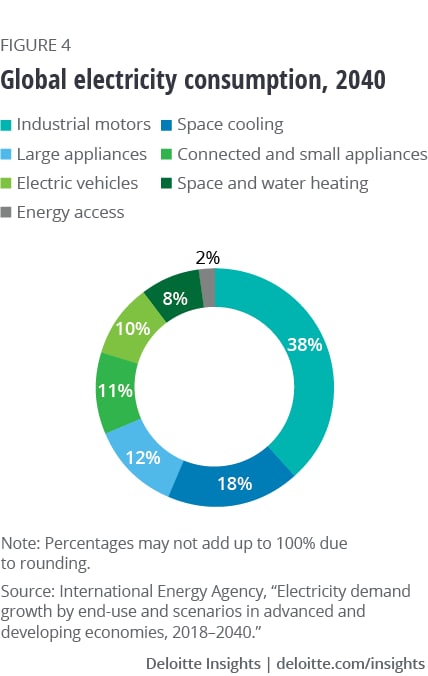
Thirty-percent of the growth in electricity demand by 2040 is expected to come from industrial motors, which are used across applications such as compressors, elevators, and pumps and are key in helping industrials meet their electrification goals.17 Industrial motors contribute to 38% of global electricity consumption (figure 4), and increasing the energy efficiency of these motors has been a consistent interest for many industrial manufacturers. From an industrial motor supply perspective, this is already happening, as original equipment manufacturers (OEMs) continue to release motors that have higher low-voltage ratings (classified as premium efficiency and super-premium efficiency). While these motors comprise a small percentage of the market today, their continued adoption could further support the sustainability objectives of industrial companies.
There are several benefits related to electrification of processes in industrial settings. Electric systems tend to have a relatively superior design, yield, process controllability, and flexibility compared with existing systems. Additionally, electric systems have a higher performance lifetime. And electrical heat pumps can be operated flexibly to balance the residual load in times of renewable production surpluses, adding to the system’s efficiency. So, while the initial equipment cost for an electric heat pump is typically higher than conventional gas heating equipment, its efficiency can be more than double the conventional system.18 The electric heat pump also generally has an extended performance cycle. This increased efficiency will likely become a focal point as companies move toward electrification.
Industrial spaces: Capturing ROI from electrification of space and water heating
Of the three focal areas for electrification in industrial manufacturing, industrial spaces seem to be receiving the least attention today. But as adoption continues with industrial fleets and processes, there is expected to be continued transition toward electric sources for space and water heating in the coming decade (figure 5). Further, the confluence of electric-powered facility heating and cooling systems and the rise of smart, connected building management systems is a powerful combination—one that could be a catalyst for using electricity to optimize industrial spaces, including factories, warehouses, and offices.19
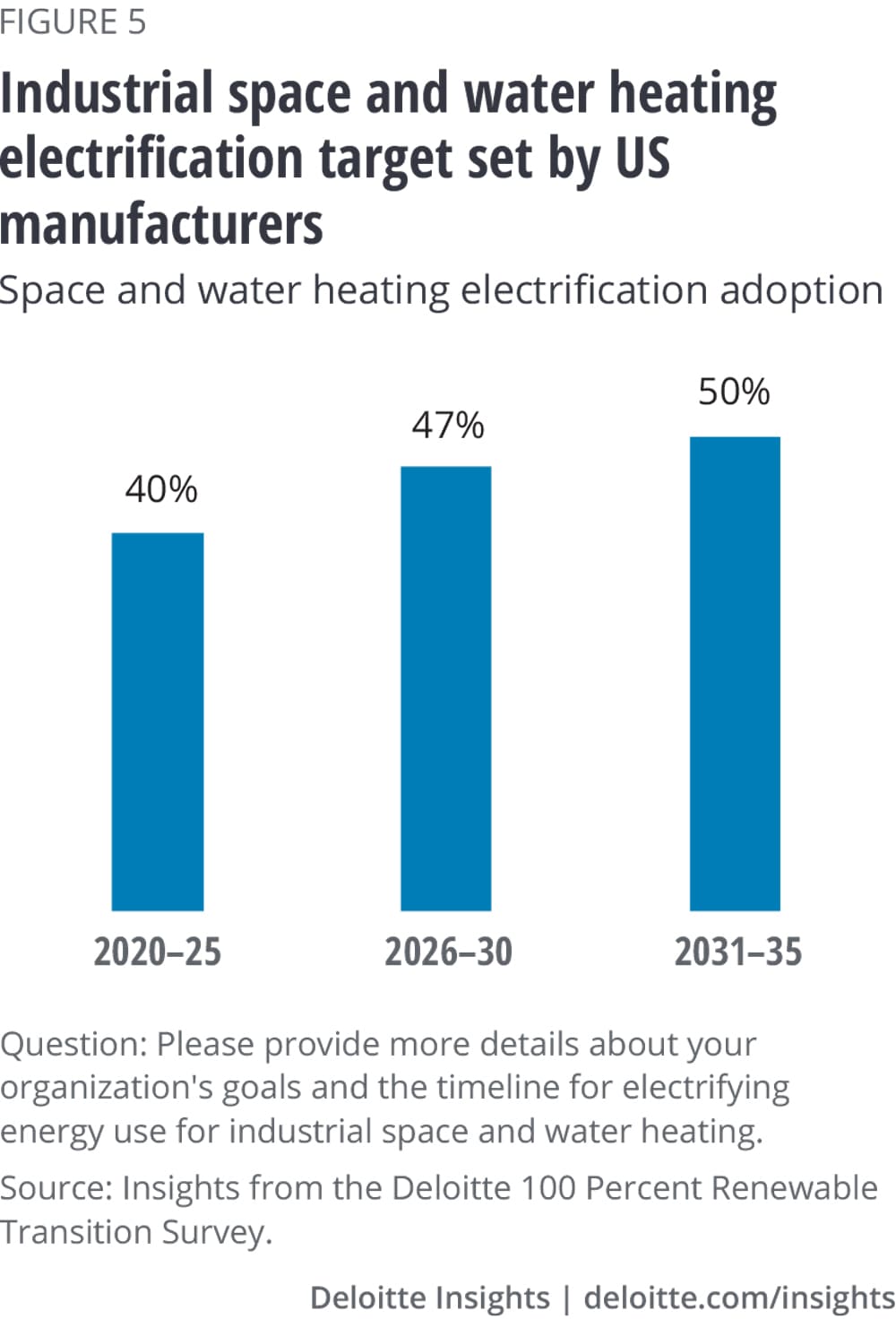
Office space utilization is seen as a major area of waste in today’s work environment. Studies have indicated that, on average, only 56% of office space is utilized, increasing to 70% during peak periods, with the rest remaining empty.20 Given the ongoing complications of worker proximity due to the recent COVID-19 pandemic, office space utilization could be even more affected in the coming months and possibly years. Electrification allows more efficient building energy management by using smart energy systems, when compared to gas or coal as an energy source. With data analytics, one can map the office footprint to reflect actual occupancy and thus help save overhead and operation costs. As manufacturers continue to focus on adding renewable sources of energy, and managing overall energy usage, this capability could become an important enabler to a reduced sustainability footprint across smart buildings and smart spaces. These new technologies may also enable building owners and occupants to participate in cost-saving utility programs, many of which are currently in pilot.
Recommendations for manufacturers
Many leading industrial manufacturers have set goals and launched initiatives that reflect the move toward electrification of industrial fleets, processes, and spaces in the coming decade. Figure 6 highlights some of these initiatives.
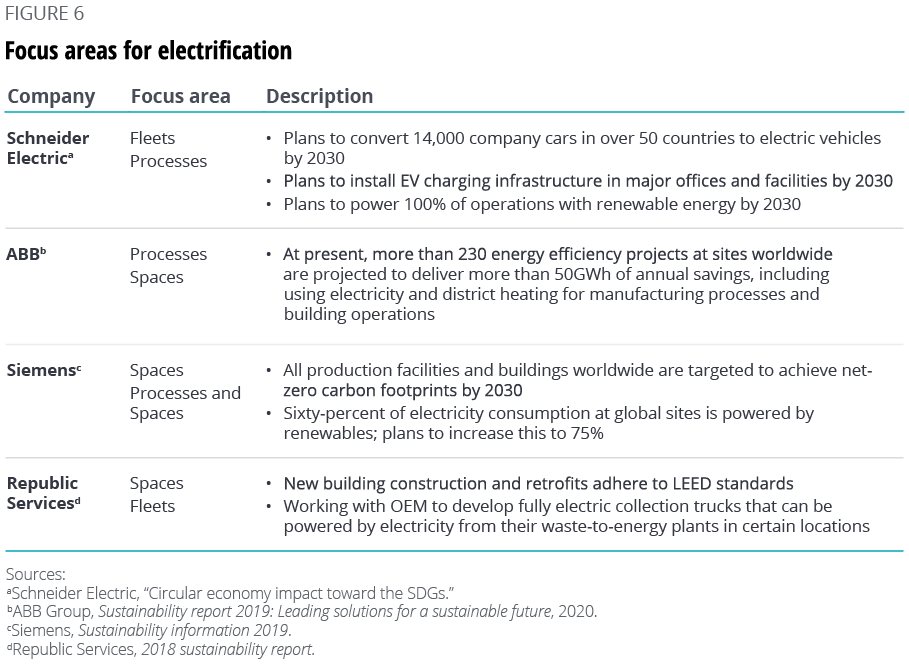
Given the potential focal points of industrial fleets, processes, and spaces, the following recommendations may help guide manufacturing leaders in their decisions:
- Consider the timing of cost parity and technology maturity for electrification across industrial processes, spaces, and fleets. Work with vendors/providers in each area to create transition plans.
- Given the diversity of the industrial base in the United States, it is important to match the strategy to the environment. For example, process electrification will likely be a viable solution for sectors that have processes where combined heat and power is not used, where induction heating technologies are viable, and/or where process heating temperatures are lower.
- Timing for electrification of specific areas such as processes or fleets will likely need to align with capital investment cycles and, for processes, any potential impact to production during the changeover.
- As a current or potential industrial fleet owner, evaluate the cost and benefits in line with the regulatory environment and create a strategy for starting the transition to electric vehicles in the coming decade. Part of the strategy can involve working with the utility to site EV charging facilities in areas that create the most value for the company and the grid.
As the United States and the rest of world progress from hydrocarbon dependence across the economy toward greater reliance on cleaner energy sources, many industrial manufacturing companies are becoming increasingly active participants in this energy transition.








